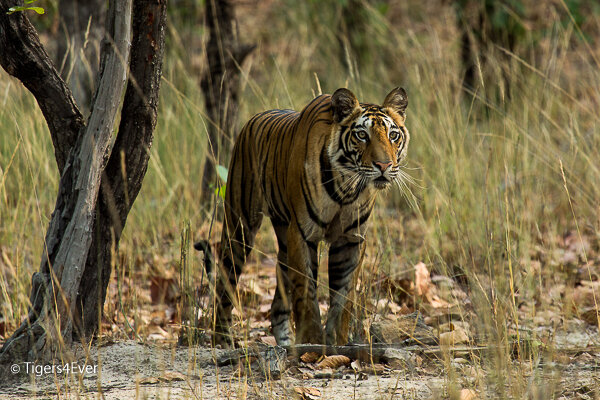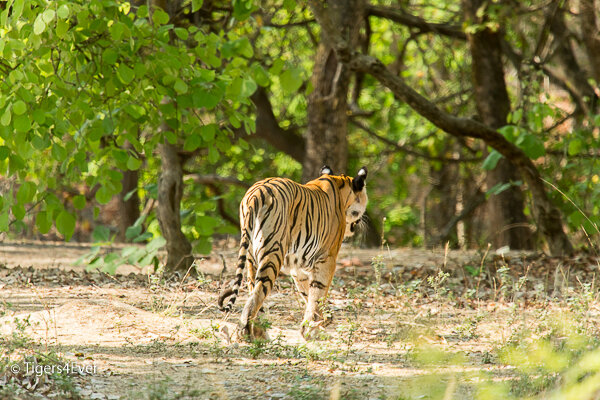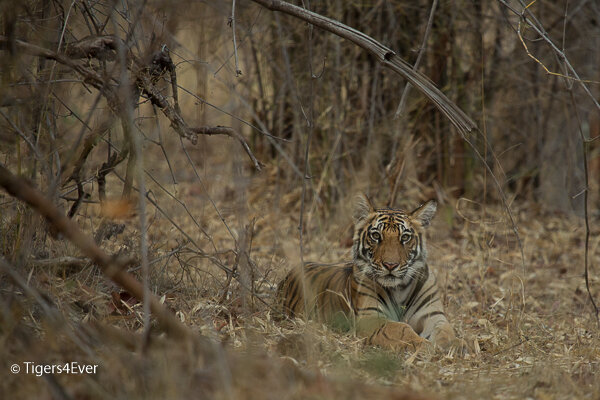By Dr. Corinne Taylor-Smith | Project Leader
Thank you so much for your incredible support for our anti-poaching patrols over the last few months. It has been an incredibly busy period for Tigers4Ever and I’m not sure that I’ll be able to fit everything into this project update report without making it more like a journal! Don’t worry though, there will be two more project reports over the next few weeks so we will be sure to cover everything across the three reports. Sadly, one of our biggest concerns this year has been the increase in both human-wildlife and tiger-tiger conflict which remain at a 15-year high. As a result, the role of our anti-poaching patrols has evolved into one of peacekeeping alongside their existing busy schedule of policing, protecting, teaching and firefighting. Without your amazing support it would be almost impossible to achieve what we have achieved in the last six months. We have successfully completed tripled patrolling for the 9 months since the end of the 2023 monsoon; and with peak poaching season the 2024 monsoon season almost upon us we will quadruple our patrolling to deal with the challenging conditions and increased risks.
Conflict is a Major Concern
The size of Bandhavgarh’s forest habitat isn’t growing but the human and wild tiger populations both are. This puts an enormous pressure on the forest habitat and the animals within. Tolerance is not usually in abundance in either the wild tiger or the human populations and thus conflict is inevitable. In the last year, we have been focussing on several initiatives to both mitigate the risk of conflict and address the consequences of the conflict when it occurs. If you have been following Tigers4Ever for some time, you will know already that we have a major project to reduce human-wildlife conflict via the installation of eco-friendly solutions such as solar powered permanent wildlife waterholes and more recently solar powered lighting at the edge of the forest where it meets high risk villages which have suffered loss of life, loss of livestock and loss of crops. In addition, we launched our Forest Safety Education initiative almost one year ago with the objective to reduce human-wildlife conflict due to accidental encounters and serendipitous attacks. We have also spent a considerable amount of time and money over the last two years replacing uniforms and equipment for the brave men and women who risk their lives daily to keep wild tigers safe.
Our anti-poaching patrollers work tirelessly day and night in some of the planet's most extreme and dangerous environments, doing one of the toughest jobs in the world, to protect wild tigers and other wildlife on the front line of conservation. Three quarters of the global wild tiger population is in India - 3167 wild tigers (785 of these are in Madhya Pradesh, where our brave patrollers work). Bandhavgarh’s wild tiger population has quadrupled from 37 in 2010, when Tigers4Ever was founded. A huge success story which would have been impossible without your help! This population continues to grow, and sadly wild tigers are dying because of Tiger-Tiger conflict. Upon hearing the aggressive roars of two wild tigers in territorial conflict (a sound which can echo up to 8 miles away!), patrollers approach with care. A wounded tiger is a very dangerous tiger and could attack and kill an unsuspecting patroller if they failed to stay alert. The patrollers look for signs of injury, blood in the sandy tracks, a lost claw or clumps of fur or skin. Where necessary they will call for the vet and/or animal recue vehicle to attend the scene if needed, but sometimes it is too late…. The victor has fled the scene, and the loser lies lifeless on the ground. The heart-breaking moment when the death of a wild tiger is confirmed, details are noted, and the post-mortem performed prior to cremating the tiger’s remains to prevent poachers and chancers taking body parts for profit. Despite it being the lore of the jungle and a natural death, it still hurts to see a once beautiful and strong wild tiger lying lifeless on the ground.
As wild tiger numbers continue to increase, sadly the risk of poaching, tiger-tiger conflict and human-tiger conflict will increase too. Wild tigers need more habitat and more protection, we have recently extended our patrolling range to include an area of forest where we know sub-adult tigers born in Bandhavgarh have migrated. There will be more natural deaths of wild tigers due to territorial conflict because more wild tigers need more wild space, and fights are more frequent. It is hard to curb the lore of the jungle without expanding or improving the forest habitat, which is something we still plan to do. We have visited some tree nurseries recently to assess the availability of saplings for our tree planting/forest rehabilitation project which we hope to launch this year. In the meantime, Tigers4Ever Trustees have purchased 12 saplings which have now been planted at Tala Camp in Bandhavgarh as a commitment to ensuring that trees will thrive in Bandhavgarh even after we are gone. In the coming months we hope to share the progress of these young trees too.
Every day we try to address these challenges head on. The number of wild tigers which died in India in 2023 reached a 15 year high (181 reported deaths – 150% of 2022 figure)! Whilst the official death toll for 2024 has reached 68 including 11 deaths due to tiger-tiger conflict in Bandhavgarh! It is vitally important that we continue our maximum level patrolling during the monsoon to keep the remaining wild tigers safe during the peak poaching season! Meanwhile, we are improving the existing wild tiger habitat to try to reduce both human-wildlife and tiger-tiger conflict via our wildlife waterholes project:https://www.globalgiving.org/projects/water-for-bandhavgarhs-tigers/.
In our last project update report, we told you about our new initiative to reduce human-wildlife conflict based on a similar project used in the Sundarbans. This involves using solar powered street lighting at the point where the forest meets the village entry point to deter wild tigers from entering the villages at night in search of prey. The early results have been promising so we have installed solar street lighting at a further 10 locations, but we still need to monitor progress over a much longer period before we can claim success.
Enhancing protection for wild tigers and their habitat ensures that more cubs survive, which means more protection is needed, and as the number of wild tigers exceeds the carrying capacity of their current habitat, further urgent action is essential. We have already reached a critical impasse in both human-wildlife and tiger-tiger conflict.
Peak Poaching Season
Thankfully, our patrolling continues to keep unnatural wild tiger deaths at bay in Bandhavgarh, but we cannot let down our guard as poachers are always lurking and seeking opportunities to strike. Your kind donations and a grant we received from Tiger Awareness in March 2024 has enabled us to fund increased patrolling into June 2024. We now plan to quadruple our patrolling for the monsoon period which is peak poaching season and the season with the most human-wildlife conflict. We hope that our supporters who can afford to do so will continue to help our anti-poaching patrols to keep wild tigers safe throughout the next three months (monsoon season) and beyond (https://goto.gg/28767).
The rollout of our safety education programme is almost complete, but our patrollers still encounter lone herders in the forest grazing their cattle and putting their lives at risk! When questioned, they say that they know about the safety advice but grazing their cattle is more important! Our patrollers inform them that people have been killed in the area by wild tigers and that if they too are killed who will support their families, some listen – others don’t! Every human death results in significant unrest in the villages and, with it the risk of retaliatory attacks on tigers by angry villagers! Such situations lead to extreme levels of human-tiger conflict and dangerous challenging times for the anti-poaching patrollers too, as they are tiger protectors and villagers can often exact revenge on them. Our patrols need to remain vigilant always, especially whilst trying to restore calm.
Our patrols remove wires and snares set to capture wild boar and herbivores which enter the villages to raid the farmers’ crops and livestock fodder. These wires and snares are indiscriminate and have killed tigers and their cubs in the past. Precious tiger lives can easily be lost when they follow their prey into the villages in search of food which is why our projects to reduce human-wildlife conflict form a vital cornerstone of our efforts to keep wild tigers safe.
We fight hard to keep both tigers and their prey out of the villages as it reduces the risk of retaliatory poisonings. The heavy rains of the monsoon season will soon replace the tough patrolling conditions of the hot drought season which can be plagued by forest fires. We continue to equip the 600 anti-poaching patrollers and chowkidars who desperately need new full uniforms and boots as they have none. So far we have supplied uniforms and boots for 420 of these brave patrollers with help from your donations, Grant Funding and our friends at Typical Tigers NFT, but it will take a mammoth fundraising effort to supply the remaining 180 before the end of this monsoon season (£5400/US$7020). https://goto.gg/56553.
Fundraising to cover our current patrolling costs continues to challenge us so we must take this into account before confirming long term plans. The poachers are aware that many cubs are now old enough to leave their mothers’ protection and make their own way in the world, so we are on high alert to curb the increased risk with quadrupled patrolling throughout the 2024 monsoon peak poaching season. These vulnerable young tigers will face many challenges as they seek a territory to call their own, not least sibling rivalry and aggression from their own parents. They will face battles with other young adult tigers seeking to establish their own territories and other adult tigers which have already staked their claim. As young tigers migrate further afield, our brave men and women patrollers will risk their lives to keep them safe. It will be a challenge to protect them all!
We are proud of our patrollers and their amazing efforts to keep wild tigers safe. During the last 3 years their workload has increased massively, and our patrollers have responded with outstanding effort and hard work to keep the poachers at bay, whilst elsewhere in India poaching activity has reached a 15-year high. It is a miracle in the circumstances that we continue to keep so many wild tigers safe!
Increased Awareness
During the monsoon season, human encroachment into the forest increases as black plum and Amla trees bear their fruit making prized pickings for the poorest people to sell. This in turn increases the risk of human-wildlife conflict as more and more villagers encounter wild tigers, elephants, leopards and snakes as they roam. Our safety education banners and handouts will ultimately save lives when people know what to do when they have a sudden encounter with a wild animal. It isn’t just the human lives which will be saved but those of the wild tigers too. This is because villagers will retaliate when a tiger attacks one of their own, such retaliation could lead to multiple deaths of both humans and tigers, so prevention is the best solution. During monsoon patrolling our brave patrollers carry laminated replicas of our safety education banners so they can show the people they encounter in the forest how to react if they meet a wild tiger, leopard, elephant or snake. The patrollers make them aware of the location of the safety information in their villages too. Raising awareness is just one vital role which our anti-poaching patrollers perform in their daily duties.
We still want to develop an audio resource for future training which can be delivered in the villages by volunteers as part of a wider awareness and environmental protection programme, however, this is subject to raising sufficient funds.
What Else are we Doing to Help
The recent increase in both human-wildlife conflict and Tiger-Tiger conflict around Bandhavgarh is a major concern, as highlighted above. As the wild tiger population continues to grow, the struggle to find sufficient territory to call home is intensifying, and conflict incidents are becoming weekly events, which is putting more pressure on the need for more water and habitat to curtail the crisis. As previously reported, we prioritised repairs of elephant and environmental damage at six of our waterhole sites in the first quarter of 2024. In the last six weeks our attention has turned to providing more permanent wildlife waterholes with work on our 20th waterhole in the Dhamokhar buffer nearing completion; and work on 3 further waterholes expected to be complete by the beginning of July 2024, bringing the total number of Tigers4Ever waterholes to 24. We still plan to put another solar-powered wildlife waterhole in the Kithauli core area although this will now be after the monsoon season or in early 2025 as we have prioritised 3 new sites where the lack of water has led to recent human-wildlife conflict, (https://goto.gg/34315). We have also erected solar-powered street lighting in 20 areas of known human-tiger conflict in the last 3 months as part of a pilot scheme to reduce the risk of tigers entering the villages and killing livestock and people. We are monitoring the results closely before rolling out the scheme in other high-risk areas.
When conflict incidents are coupled with the increased risk of poaching activities, it means that our patrollers need to be on high alert at all times. We must ensure that we can maintain a minimum of quadrupled patrolling especially throughout the next three months when we know that the poachers will be very active. https://goto.gg/28767.
Making a Difference
Thanks to your continued support, we can cover an extra 2700 km (1678 miles) of wild tiger territory per month with our quadrupled patrols. The patrollers need sufficient time to search for snares; traps and signs of poisoners around forest areas where human encroachment is widespread, especially during the monsoon season when poachers are more active. We also need to maintain our patrols around the periphery of villages where crop raiding and livestock killing is rife. Our increased patrolling helps us to curb human encroachment into wild tigers’ territories and allows us to provide safety advice for those trying to protect their crops and livestock from wandering elephants and tigers respectively.
Small charities like Tigers4Ever rely greatly on individual donors like you to be able to deliver our essential services to keep wild tigers safe. Thus, your donations are critical to ensuring that we can provide the best possible protection for the increasing wild tiger and cub population.
We are currently protecting more wild tigers and cubs than ever before, and your help is crucial in ensuring that we can keep them safe. We know that there are at least 22 precious small cubs which are totally dependent on their mothers for survival so we will be working even harder to keep the mothers safe. Your gift, however large or small can make a huge difference as to whether Bandhavgarh’s wild tigers and cubs can survive the unprecedented threats they face:
Without our help, we know that more wild tigers will die; and more humans will be mauled or killed due to encroachment or human-tiger conflict. Sadly, with every human life lost comes another threat to the wild tiger’s survival in the form of retaliation; thus, we must protect both if we are to ensure that wild tigers can have a wild future.
Please don’t hesitate if you can help, your donation can be the difference between life and death for a wild tiger, as it helps to increase our patrolling when it is most needed. Every tiger and every tiger cub counts. Thank you for making our fight against poachers, the changing climate and human-animal conflict possible. (https://goto.gg/28767).
Links:
Project reports on GlobalGiving are posted directly to globalgiving.org by Project Leaders as they are completed, generally every 3-4 months. To protect the integrity of these documents, GlobalGiving does not alter them; therefore you may find some language or formatting issues.
If you donate to this project or have donated to this project, you can receive an email when this project posts a report. You can also subscribe for reports without donating.
Support this important cause by creating a personalized fundraising page.
Start a Fundraiser

